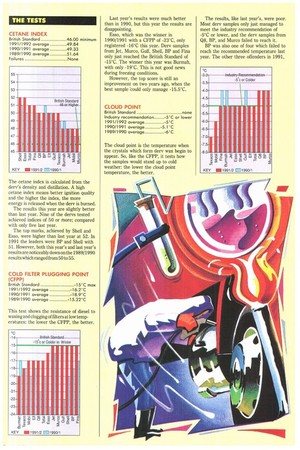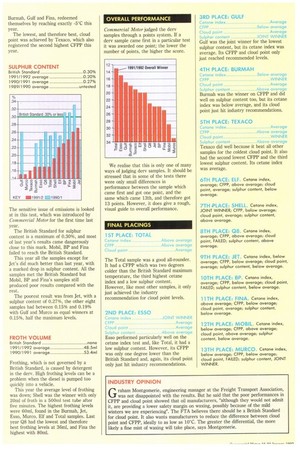THE DIES E L
Page 36

Page 37

Page 38

If you've noticed an error in this article please click here to report it so we can fix it.
It's that time of year again! Commercial Motor has put 13 major dervs to the test, assessing how they stand up to cold conditions and how environmentally friendly they are. Our samples came from filling stations across the country, and were collected in five-litre plastic containers. Obviously this is not a definitive test because it uses only one sample for each make of dery — truck operators can't always pick and choose where their dery comes from and a "one-shot" test reflects that. All samples were tested by independent fuel analyst Caleb Brett International at West Thurrock, Essex. CETANE INDEX
British Standard 46.00 minimum 1991/1992 average 49.84 1990/1991 average 49.33 1989/1990 average 51.64 Failures None
The cetane index is calculated from the derv's density and distillation. A high cetane index means better ignition quality and the higher the index, the more energy is released when the dery is burned.
The results this year are slightly better than last year. Nine of the dervs tested achieved indices of 50 or More; compared with only five last year.
The top marks, achieved by Shell and Esso, were higher than last year at 52. In 1991 the leaders were BP and Shell with 51. However, both this year's and last year's results are noticeably down on the 1989/1990 results which ranged from 50 to 55.
This test shows the resistance of diesel to waxing and clogging of filters at low temperatures: the lower the CFPP, the better. Last year's results were much better than in 1990, but this year the results are disappointing.
Esso, which was the winner in 1990/1991 with a CFPP of -23°C, only registered -16°C this year. Dery samples from Jet, Murco, Gulf, Shell, BP and Fina only just reached the British Standard of -15°C. The winner this year was Burmah, with only -19°C. This is not good news during freezing conditions.
However, the top score is still an improvement on two years ago, when the best sample Could only manage -15.5°C.
CLOUD POINT
British Standard none Industry recommendation -5°C or lower 1991/1992 average -5°C 1990/1991 average -5.1°C 1989/1990 average -6°C
The cloud point is the temperature when the crystals which form dery wax begin to appear. So, like the CFPP, it tests how the samples would stand up to cold weather: the lower the cloud point temperature, the better.
The results, like last year's, were poor. Most dery samples only just managed to meet the industry recommendation of -5°C or lower, and the dery samples from Q8, BP, and Murco failed to reach it.
BP was also one of four which failed to reach the recommended temperature last year. The other three offenders in 1991, Burmah, Gulf and Fina, redeemed themselves by reaching exactly -5°C this year.
The lowest, and therefore best, cloud point was achieved by Texaco, which also registered the second highest CFPP this year.
SULPHUR CONTENT
British Standard 0.30% 1991/1992 average 0.20% 1990/1991 average 0.27% 1989/1990 average untested
The sensitive issue of emissions is looked at in this test, which was introduced by Commercial Motor for the first time last year.
The British Standard for sulphur content is a maximum of 0.30%, and most of last year's results came dangerously close to this mark. Mobil, BP and Fina failed to reach the British Standard.
This year all the samples except for Jet's did much better than last year, with a marked drop in sulphur content. All the samples met the British Standard but Mobil, BP and Fina's samples still produced poor results compared with the rest.
The poorest result was from Jet, with a sulphur content of 0.27%, the other eight samples had between 0.15% and 0.19% with Gulf and Murco as equal winners at 0.15%, half the maximum levels.
FROTH VOLUME
British Standard none 1991/1992 average 48.5m1 1990/1991 average 53.4m1
Frothing, which is not governed by a British Standard, is caused by detergent in the derv. High frothing levels can be a problem when the diesel is pumped too quickly into a vehicle.
This year the average level of frothing was down; Shell was the winner with only 20m1 of froth in a 500m1 test tube after five minutes. The highest frothing levels were 60m1, found in the Burmah, Jet, Esso, Murco, Elf and Total samples. Last year Q8 had the lowest and therefore best frothing levels at 36m1, and Fina the highest with 80m1. OVERALL PERFORMANCE Commercial Motor judged the dery samples through a points system. If a dery sample came first in a particular test it was awarded one point; the lower the number of points, the higher the score.
We realise that this is only one of many ways of judging dery samples. It should be stressed that in some of the tests there were only small differences in performance between the sample which came first and got one point, and the same which came 13th, and therefore got 13 points. However, it does give a rough, visual guide to overall performance.
FINAL PLAC1NGS
1ST PLACE: TOTAL
Cetane index Above average CFPP Above average Cloud point Average
The Total sample was a good all-rounder. It had a CFPP which was two degrees colder than the British Standard maximum temperature, the third highest cetane index and a low sulphur content.
However, like most other samples, it only just achieved the industry recommendation for cloud point levels.
2ND PLACE: ESSO
Cetane index JOINT WINNER CFPP Average Cloud point Average Sulphur content Above average
Esso performed particularly well on the cetane index test and, like Total, it had a low sulphur content. However, its CFPP was only one degree lower than the British Standard and, again, its cloud point only just hit industry recommendations. 3RD PLACE: GULF
Cetane index Average CFPP Below average Cloud point Average Sulphur content JOINT WINNER
Gulf was the joint winner for the lowest sulphur content, but its cetane index was average. Its CFPP and cloud point only just reached recommended levels.
4TH PLACE: BURMAH
Cetane index Below average CFPP WINNER Cloud point Average Sulphur content Above average
Burmah was the winner on CFPP and did well on sulphur content too, but its cetane index was below average, and its cloud point just hit industry recommendations.
5TH PLACE: TEXACO
Cetane index Average CFPP Above average Cloud point WINNER
Sulphur content Above overage
Texaco did well because it beat all other samples for the coldest cloud point. It also had the second lowest CFPP and the third lowest sulphur content. Its cetane index was average.
6TH PLACE: ELF. Cetane index, average; CFPP, above average; cloud point, average; sulphur content, below average.
7TH PLACE: SHELL. Cetane index, JOINT WINNER; CFPP, below average; cloud point, average; sulphur content, above average.
8TH PLACE: 08. Cetane index, average; CFPP, above average; cloud point, FAILED; sulphur content, above average.
9TH PLACE: JET. Cetane index, below average; CFPP, below average; cloud point, average; sulphur content, below average.
10TH PLACE: BP. Cetane index, average; CFPP, below average; cloud point, FAILED; sulphur content, below average.
11TH PLACE: FINA. Cetane index, above average; CFPP, below average; cloud point, average; sulphur content, below average.
12TH PLACE: MOBIL. Cetane index, below average; CFPP, above average; cloud point, above average; sulphur content, below average.
13TH PLACE: MURCO. Cetane index, below average; CFPP, below average; cloud point, FAILED; sulphur content, JOINT WINNER.




















































































